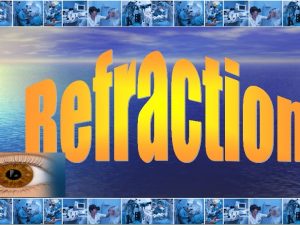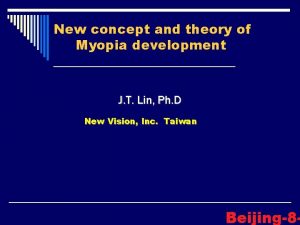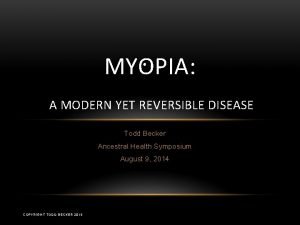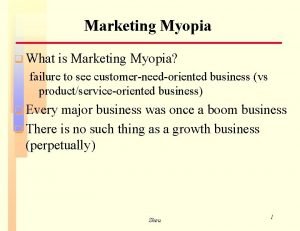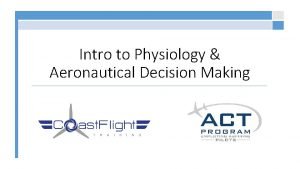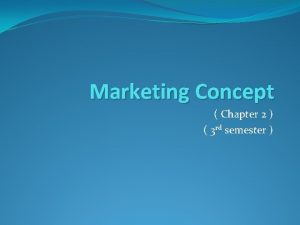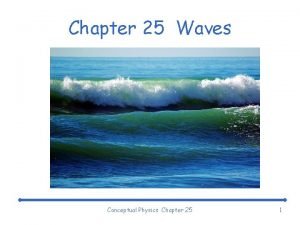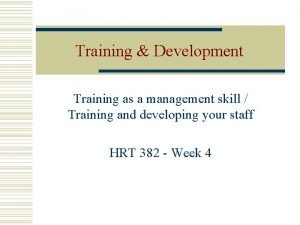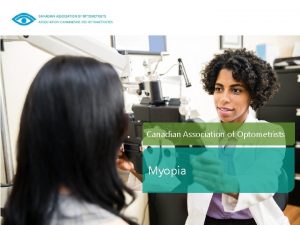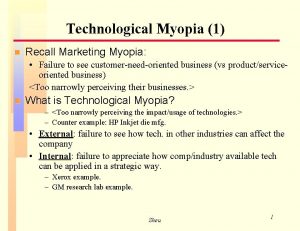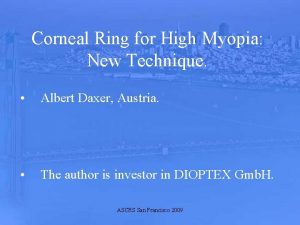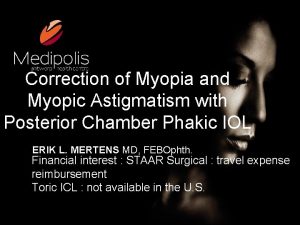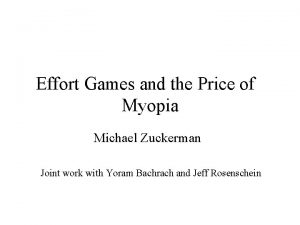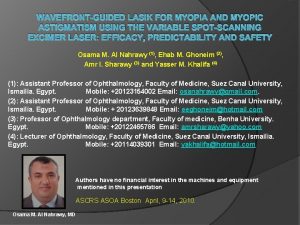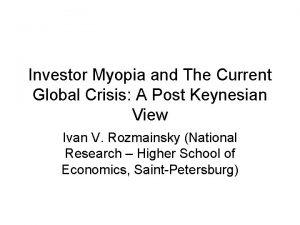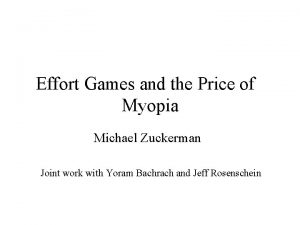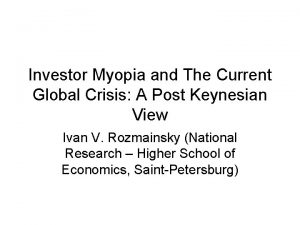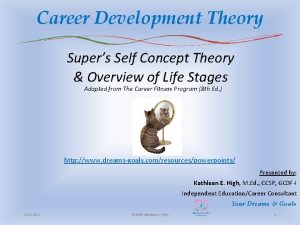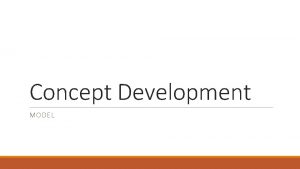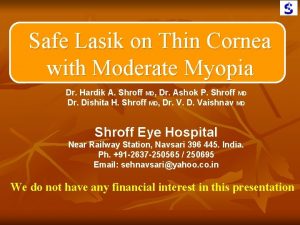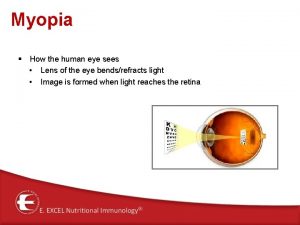New concept and theory of Myopia development J












![Higher lens power in [short] eye hyperopes lower lens power in hyperopes with eyes Higher lens power in [short] eye hyperopes lower lens power in hyperopes with eyes](https://slidetodoc.com/presentation_image/2a159f77fc6800b8e343177126225eb6/image-13.jpg)











- Slides: 24

New concept and theory of Myopia development ______________ J. T. Lin, Ph. D New Vision, Inc. Taiwan Beijing-8 -

Summary (1) (2) (3) (4) (5) (6) Human eye optics New concept of myopia The ratio: L/r =3. 0 The growth rate theory The lens paradox Axial growth factors (defocusing, accommod) (7) Myopia predictor


Human eye optics S X Myopia F D 1 CORNEA D 2 LENS Hyperopia Retina

Effective eye model (Lin, 2005) S X L P 2 P 1 CORNEA LENS L = S + X + a. T 2 De = z [ P 3 – P 1/z – P 2 ] z = (1 - S/f) = 1 - S P 1/1336 = 0. 8 to 0. 85

The basic myopic-theory (Lin, 2005) (1) Axial growth is triggered by (a) : retina defocusing, (b) (lens) accommondation (deshaping and translation). (2) Refractive errors resulted from the mismatching of ocular components growth rates De = Do + (d. D 1 + z 2 d. D 2) - md. L initial cornea lens axial m=4. 0 to 2. 5 D/mm, (depnding on age) Conditions of emmetropization: (a) Do >2. 0 ; (b) md. L < Do + [d. D 1 + z 2 d. D 2 ] Otherwise, myopia [De<0] will develop due to anormal axial growth. (md. L)

Myopia predictor Garner (2002), axial growth rate (per year) > 0. 12 mm Olson (2007) regression Eq, (data, mean value) De= 110 – 2. 43 L – 0. 89 P 1 - 0. 62 P 2 De=0, for L= 23, P 1=43, need P 2=24. 8 D. Lin (2005), rate theory for L = 24 = S 1 + S 2 + T. De= 1. 39 (S 1 - 3. 3) – 2. 76 (S 2 - 16. 7) – 2. 9 (T – 4. 0) – 1. 0 (43 - P 1) – 0. 75 (23 -P 2) 0

New criterion for myopia-axial length L*=24 - 0. 36(P 1 -43) - 0. 23(P 2 -23) - 0. 5(So-3. 3) - 0. 35(T-4. 0) L*=24, for (P 1, P 2, So, T)=(43, 23, 3. 3, 4. 0) Example: L=26 mm could be myop or hyper, D= -1. 5, if L*=25 D=+2. 5, if L*=27 ). * JT Lin (Chin J O P, 2005, 145 -151). CK Chang, JT Lin, IJO (8/2017 0

New definition of Refractive States Emmetropic has been defined by ratios: H/L =1. 0, L/r =3. 0 , New ratios: C 1=L/r , C 2=L/R L r H L R (1) C 1=L/r=3. 0 – 0. 0036 De (2) 0. 25 C 1 +0. 126 C 2 = 1+2. 97/L –L De * JT Lin (Chin J Oph opt. 2005, 1 - 6; and 145 -151). 0

Shanghai/2005, N=3922 (data) Age 6 -12 De =44. 7 – 15. 1 (L /r) L /r = 2. 96 – 0066 De Lin (theory, 2005) L /r = 3. 0 – (0. 003 L) De =3. 0 – 0. 066 De, for L = 22 mm.

N=167, age>40 De= 35. 8 - 1. 59 L Lin (theory, 2005) De = 62 – (2. 76 L – 1. 37 d. S)

Iribarren (Review, 2016) Age L (mm) Cornea Lens 0 16. 8 51 34 Age 0 10 -20 20 -80 T 4. 0 3. 8 – 4. 8 n 1. 45 1. 44 1. 435 c- 1. 415 Lens paradox resolved by the index decrease by age, compensates the power increase due to thickness increase. 10 -20 23. 6 43 19 50 - 80 43 21 - 19
![Higher lens power in short eye hyperopes lower lens power in hyperopes with eyes Higher lens power in [short] eye hyperopes lower lens power in hyperopes with eyes](https://slidetodoc.com/presentation_image/2a159f77fc6800b8e343177126225eb6/image-13.jpg)
Higher lens power in [short] eye hyperopes lower lens power in hyperopes with eyes with similar length as emmetropes. Refractive group AL/CR Mean SE Lens power Hyperopes with 75 low L/r 2. 86* 2. 89* 23. 13* Hyperopes with 193 normal L/r 3. 0 1. 54* 21. 96* Emmetropes 3. 03 0. 22 22. 54 n= 528 Irribennar (2015)

Myopia predictor (Lin, 2005) Garner (2002, data), axial growth rate (per year) N > 0. 12 mm Lin (2005, theory), d. De/d. A = -m(d. L/d. A) – z 2 (d. D 2/d. A) axial lens = m. N - z 2 M solve for myopic predictor rate N = -z 2 M/m. (012, Garner, 2002) Myopia onset age (A*) A* = A + (L 23)/N

Growth (age 0 to 3 yrs), (Data: Lam, 2002) De 3. 5 De drops fast by age 1. 0 0 0 3 Age (year) 6

Ocular power growth (age 0 to 60 yrs) L, Dj 24 Axial length Corneal power Lens power 17 0 3 20 40 Age (year) 60

Ocular power growth (age 0 to 60 yrs) +4. 0 +2. 0 Presbyopia emmetropia 0 0 3 20 40 Age (year) 60



Conclusions (1) Axial growth is trigered by (a) : retina defocusing. (b) lens accommondation (deshaping and translation). (2) Refractive errors resulted from the mismatching of ocular components growth rates De = Do + (d. D 1 + z 2 d. D 2) - md. L initial cornea lens axial (4) Conditions of emmetropization: (a) initial hyperopic [Do > +2. 0 ]; (b) axial power growth larger than the [corneal+ lens] power decrease, with a PERFECT match to the age-0 power. (Do) (5) Myopic on-set can be predicted, but it requires both age growth rate of the axial-length (N) and lens (M). . Garner predictor (N>0. 12 mm) is not sufficient. (6) L/r ration of 3. 0 needs revision to: 3. 0 + 0. 03 L De.


Lens paradox (preby with age) Refractive changes with (dashed) and without cataract Hashemi et al, Cli Exp Ophal (2015) Jongenelen et al, Vis Psy Phys Opt ( 2015)


Eye-Accommodation d. S o Lin’s 2 -component theory (Lin, JRS, 2005) A = A 1 + A 2 A 1 = M d. S A 2 = 83 (1/R’ – 1/R) S M = (0. 9 – 1. 5) (D/mm) A 2 = 1. 6 D (for d. R= 1. 0 mm) R’
 Astenopy
Astenopy Myopia power
Myopia power Zenni optical lens types
Zenni optical lens types Marketing myopia meaning
Marketing myopia meaning Pave checklist
Pave checklist Empty-field myopia
Empty-field myopia Forster fuchs spots
Forster fuchs spots Serumen ads icd 10
Serumen ads icd 10 Old concept of marketing
Old concept of marketing Conceptual physics chapter 25
Conceptual physics chapter 25 Ask concept in training and development
Ask concept in training and development Development of a restaurant concept
Development of a restaurant concept Ask concept in training and development
Ask concept in training and development Example of ideal self
Example of ideal self Contoh marketing concept
Contoh marketing concept New york, new jersey, pennsylvania, and delaware
New york, new jersey, pennsylvania, and delaware New oil and new wineskin
New oil and new wineskin Both new hampshire and new york desire more territory
Both new hampshire and new york desire more territory What is new marketing realities
What is new marketing realities New classical macroeconomics
New classical macroeconomics Chapter 16 toward a new heaven and a new earth
Chapter 16 toward a new heaven and a new earth Leanne keene french ambassador arrives from paris
Leanne keene french ambassador arrives from paris New classical and new keynesian macroeconomics
New classical and new keynesian macroeconomics New product development and product life cycle strategies
New product development and product life cycle strategies Microsoft new england research and development center
Microsoft new england research and development center
